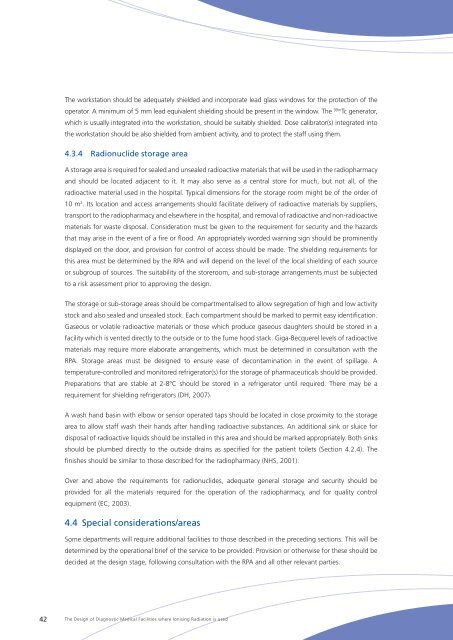The Design of Diagnostic Medical Facilities where ... - ResearchGate
The Design of Diagnostic Medical Facilities where ... - ResearchGate
The Design of Diagnostic Medical Facilities where ... - ResearchGate
Create successful ePaper yourself
Turn your PDF publications into a flip-book with our unique Google optimized e-Paper software.
<strong>The</strong> workstation should be adequately shielded and incorporate lead glass windows for the protection <strong>of</strong> the<br />
operator. A minimum <strong>of</strong> 5 mm lead equivalent shielding should be present in the window. <strong>The</strong> 99m Tc generator,<br />
which is usually integrated into the workstation, should be suitably shielded. Dose calibrator(s) integrated into<br />
the workstation should be also shielded from ambient activity, and to protect the staff using them.<br />
4.3.4 Radionuclide storage area<br />
A storage area is required for sealed and unsealed radioactive materials that will be used in the radiopharmacy<br />
and should be located adjacent to it. It may also serve as a central store for much, but not all, <strong>of</strong> the<br />
radioactive material used in the hospital. Typical dimensions for the storage room might be <strong>of</strong> the order <strong>of</strong><br />
10 m 2 . Its location and access arrangements should facilitate delivery <strong>of</strong> radioactive materials by suppliers,<br />
transport to the radiopharmacy and else<strong>where</strong> in the hospital, and removal <strong>of</strong> radioactive and non-radioactive<br />
materials for waste disposal. Consideration must be given to the requirement for security and the hazards<br />
that may arise in the event <strong>of</strong> a fire or flood. An appropriately worded warning sign should be prominently<br />
displayed on the door, and provision for control <strong>of</strong> access should be made. <strong>The</strong> shielding requirements for<br />
this area must be determined by the RPA and will depend on the level <strong>of</strong> the local shielding <strong>of</strong> each source<br />
or subgroup <strong>of</strong> sources. <strong>The</strong> suitability <strong>of</strong> the storeroom, and sub-storage arrangements must be subjected<br />
to a risk assessment prior to approving the design.<br />
<strong>The</strong> storage or sub-storage areas should be compartmentalised to allow segregation <strong>of</strong> high and low activity<br />
stock and also sealed and unsealed stock. Each compartment should be marked to permit easy identification.<br />
Gaseous or volatile radioactive materials or those which produce gaseous daughters should be stored in a<br />
facility which is vented directly to the outside or to the fume hood stack. Giga-Becquerel levels <strong>of</strong> radioactive<br />
materials may require more elaborate arrangements, which must be determined in consultation with the<br />
RPA. Storage areas must be designed to ensure ease <strong>of</strong> decontamination in the event <strong>of</strong> spillage. A<br />
temperature-controlled and monitored refrigerator(s) for the storage <strong>of</strong> pharmaceuticals should be provided.<br />
Preparations that are stable at 2-8ºC should be stored in a refrigerator until required. <strong>The</strong>re may be a<br />
requirement for shielding refrigerators (DH, 2007).<br />
A wash hand basin with elbow or sensor operated taps should be located in close proximity to the storage<br />
area to allow staff wash their hands after handling radioactive substances. An additional sink or sluice for<br />
disposal <strong>of</strong> radioactive liquids should be installed in this area and should be marked appropriately. Both sinks<br />
should be plumbed directly to the outside drains as specified for the patient toilets (Section 4.2.4). <strong>The</strong><br />
finishes should be similar to those described for the radiopharmacy (NHS, 2001).<br />
Over and above the requirements for radionuclides, adequate general storage and security should be<br />
provided for all the materials required for the operation <strong>of</strong> the radiopharmacy, and for quality control<br />
equipment (EC, 2003).<br />
4.4 Special considerations/areas<br />
Some departments will require additional facilities to those described in the preceding sections. This will be<br />
determined by the operational brief <strong>of</strong> the service to be provided. Provision or otherwise for these should be<br />
decided at the design stage, following consultation with the RPA and all other relevant parties.<br />
42<br />
<strong>The</strong> <strong>Design</strong> <strong>of</strong> <strong>Diagnostic</strong> <strong>Medical</strong> <strong>Facilities</strong> <strong>where</strong> Ionising Radiation is used
















